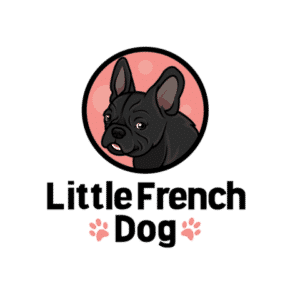French Bulldogs come in a variety of colors and patterns, including blue, chocolate, merle, pied, black, brindle, fawn, and white. Each color has its own unique characteristics.
French Bulldogs, also known as “Frenchies,” are a popular and beloved dog breed originating in France. These small, muscular dogs are known for their distinctive “bat-like” ears, wrinkled faces, and affectionate personalities. French Bulldogs have become increasingly popular in recent years, with many people drawn to their unique appearance and gentle nature.
The breed was originally developed as a companion animal, and French Bulldogs have become known for their loyalty and affectionate personalities. They are friendly and outgoing, making great pets for families with children or anyone who wants a loyal and loving companion.
Standard French Bulldog
These dogs are known for their distinctive appearance, which includes a short snout, bat-like ears, and a compact, muscular build. Here are some of the standard characteristics of the French Bulldog breed:
- Size: French Bulldogs are small dogs, typically weighing between 16-28 pounds and standing around 11-12 inches tall at the shoulder.
- Appearance: Frenchies have a distinctive appearance, with a short snout, bat-like ears, and a muscular, compact body. They have a smooth, short coat that can come in a variety of colors, including brindle, fawn, black, white, blue, and more.
- Temperament: French Bulldogs are known for their affectionate and friendly personalities. They are loyal and loving and make great pets for families with children or for anyone who wants a loyal and affectionate companion.
- Health: French Bulldogs can be prone to certain health issues, including respiratory problems, hip dysplasia, skin allergies, and eye and ear infections. It is important to provide proper care and regular veterinary check-ups to ensure that your Frenchie stays healthy.
- Exercise: While French Bulldogs are small dogs, they still require regular exercise to stay healthy and happy. They enjoy short walks and indoor playtime but can become overheated and tired easily due to their short snouts.
French Bulldogs are known for their affectionate and friendly personalities, making them popular as family pets and companions. They have a unique temperament characterized by loyalty, playfulness, and adaptability.
One of the defining characteristics of the French Bulldog’s personality is their love for human interaction. They crave attention and love to be near their owners, which can make them great lap dogs. They are also known for being adaptable and can live in a variety of living situations, including apartments or homes with small yards.
Another important aspect of their personality is their playful and curious nature. French Bulldogs love to play and can often chase after toys or engage in other forms of play. They are also known for their ability to adapt to new situations and environments, which makes them great travel companions.
Miniature French Bulldog
While they share many similarities, there are also some key differences to be aware of.
The most obvious difference between the standard and miniature breeds is their size. Standard French Bulldogs typically weigh between 16-28 pounds and stand around 11-12 inches tall at the shoulder. On the other hand, Miniature French Bulldogs are smaller in size, usually weigh between 11-16 pounds, and stand around 10 inches tall at the shoulder.
Aside from size, there are some other notable differences between the standard and miniature breeds. For example, the miniature breed is sometimes referred to as the Teacup French Bulldog and is often bred for its smaller size. This can lead to certain health issues, such as respiratory problems and other health complications, so it’s important to ensure that the breeder you choose is reputable and responsible.
The standard and miniature French Bulldogs are very similar in temperament and personality. They are both known for their friendly and affectionate personalities and make great pets and companions for families and individuals alike. Both breeds are adaptable and can thrive in a variety of living situations, including apartments and homes with small yards.
When it comes to training and exercise, both standard and miniature French Bulldogs require similar levels of activity and training. They enjoy short walks and indoor playtime but can become overheated and tired easily due to their short snouts.
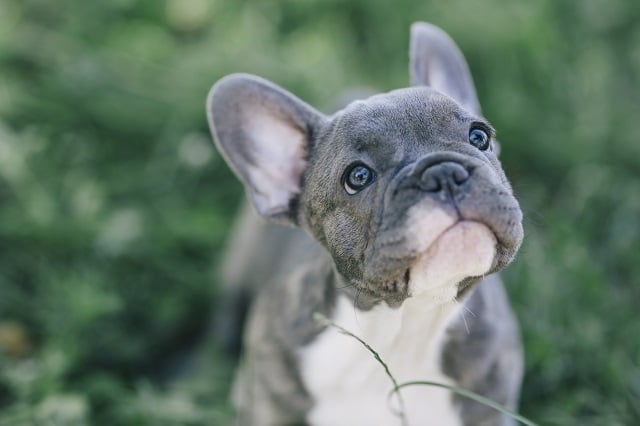
Blue French Bulldog
“Blue” is a term used to describe a unique and rare color found in French Bulldogs. Blue French Bulldogs have a distinctive coat that ranges in color from a light silvery gray to a deep blue-gray. The reason for this coloration is due to a dilution gene that affects the pigment in their fur.
While the blue coat is highly sought after, it is not considered an official color by the American Kennel Club (AKC), which is the governing body that sets breed standards for French Bulldogs. The AKC only recognizes nine colors as being official for the breed, including fawn, brindle, and white.
It is important to note that breeding for blue coats in French Bulldogs can be controversial, as it often involves selective breeding and inbreeding, which can lead to certain health problems. Blue French Bulldogs can also be more expensive than other colors due to their rarity and high demand.
Despite not being an official AKC color, blue French Bulldogs have become increasingly popular in recent years and are highly prized for their unique and striking appearance. They are known for their friendly and affectionate personalities, making them great companions for individuals and families alike. Suppose you are considering adding a blue French Bulldog to your family. In that case, it’s important to research and chooses a reputable breeder who prioritizes the health and well-being of their dogs.
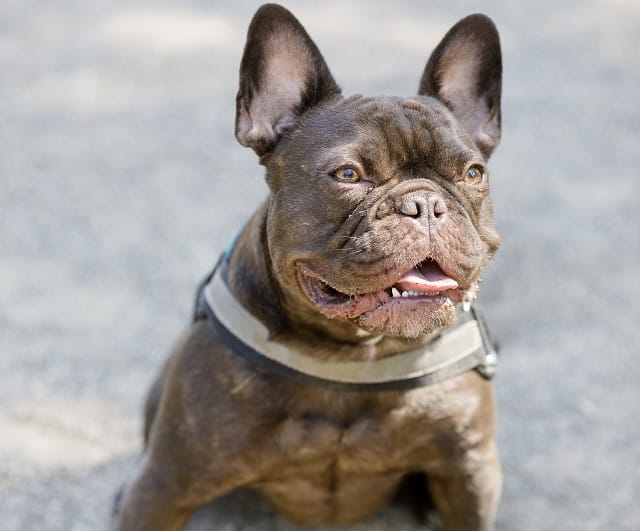
Chocolate French Bulldog
Chocolate” is a term used to describe a rare and unique coat color found in French Bulldogs. This color is a deep, rich brown that resembles the color of chocolate. This distinctive color is due to a specific genetic mutation that affects the pigmentation of the dog’s fur.
While chocolate French Bulldogs are highly desired, it is important to note that this color is not considered an official color by the American Kennel Club (AKC), which is the governing body that sets breed standards for French Bulldogs. The AKC only recognizes nine colors as being official for the breed, including fawn, brindle, and white.
To produce puppies with the desired chocolate color, breeders must use careful breeding practices, which often involve breeding two dogs with the chocolate gene. This can increase the risk of health problems associated with inbreeding, and it’s essential to choose a reputable breeder who uses responsible breeding practices and prioritizes the health and well-being of their dogs.

Merle French Bulldog
The term “merle” is used to describe a specific coat pattern found in some French Bulldogs. This pattern is characterized by a mottled, marbled appearance, with patches of color interspersed with areas of lighter pigmentation. The result is a striking, unique appearance that sets merle French Bulldogs apart from other colors.
The merle pattern is caused by a specific genetic mutation that affects the distribution of pigment in the dog’s fur. This mutation can lead to a range of colors, from blue merle (grey and black patches on a silver or blue base) to chocolate merle (brown patches on a chocolate or red base).
The merle gene, which is responsible for the striking coat pattern found in merle French Bulldogs, is also associated with a higher risk of certain health problems. Specifically, if a dog inherits two copies of the merle gene, it can lead to a condition called “double merle” or “lethal white,” which can cause health issues such as deafness and blindness.
Homozygous dogs, meaning they inherit two copies of the merle gene, are more likely to develop these health problems than heterozygous dogs, meaning they inherit only one copy of the gene. Responsible breeders take great care to avoid breeding two merle French Bulldogs together to prevent these health issues from occurring.
Despite the potential health risks associated with the merle gene, merle French Bulldogs remain popular and highly desired among dog enthusiasts. Their unique appearance and playful personalities make them a great choice for families or individuals looking for a loyal companion. However, it is essential to remember that the most important factor when choosing a French Bulldog should always be their health and well-being rather than their coat color or pattern.
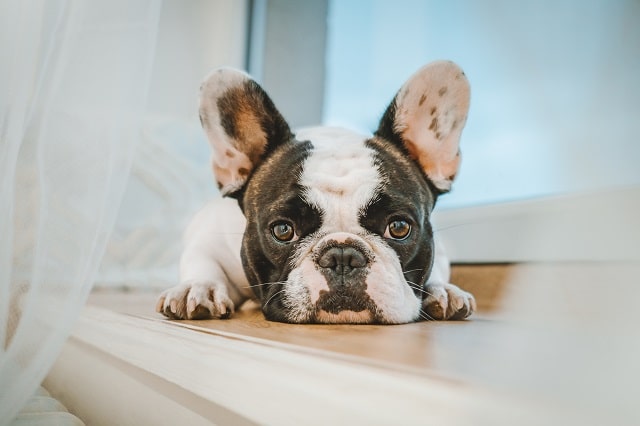
Pied French Bulldog
The term “pied” is used to describe a specific coat pattern found in French Bulldogs. A predominantly white coat characterizes this pattern with patches of color on the face, ears, and body. The result is a striking and unique appearance that sets pied French Bulldogs apart from other colors.
The term “pied” comes from the French word “pie,” which means magpie. This is because the piebald pattern seen in pied French Bulldogs resembles a magpie bird’s black and white coloration.
It is important to note that while pied French Bulldogs are highly sought after for their distinctive appearance, the pied color pattern is not an official color recognized by the American Kennel Club (AKC). This is because the pied pattern is caused by a complex interaction of multiple genes, which can lead to a wide range of variations in the coat pattern.
Despite this, pied French Bulldogs remain popular and highly desired among dog enthusiasts. Their unique appearance, playful personalities, and loyal nature make them a great choice for families or individuals looking for a devoted companion. However, it is essential to remember that the most important factor when choosing a French Bulldog should always be their health and well-being rather than their coat color or pattern. It is crucial to choose a reputable breeder who uses responsible breeding practices and prioritizes the health and well-being of their dogs, regardless of their coat color or pattern.
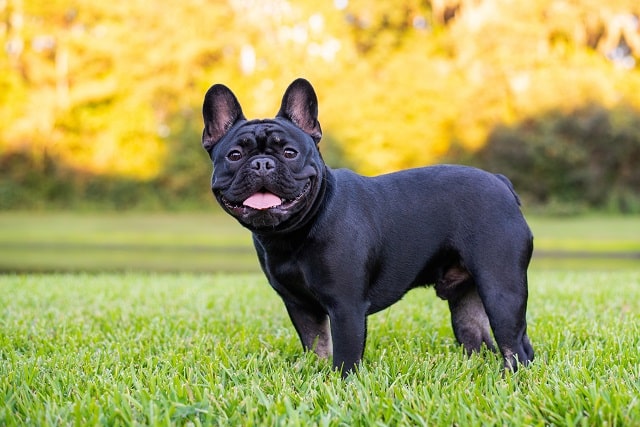
Black French Bulldog
French Bulldogs can come in a range of colors, including fawn, brindle, and white. However, some French Bulldogs have a solid black coat color, which is simply referred to as “black.”
The black coat color in French Bulldogs is the result of specific genetic variations that affect the production of melanin, the pigment responsible for skin and coat color. The black coat is a result of a dominant gene that overrides other coat colors, resulting in a dog with a solid black coat.
Black French Bulldogs can be highly sought after for their sleek and striking appearance. However, it is essential to remember that coat color should not be the only consideration when choosing a French Bulldog. It is crucial to choose a reputable breeder who uses responsible breeding practices and prioritizes the health and well-being of their dogs, regardless of their coat color or pattern.
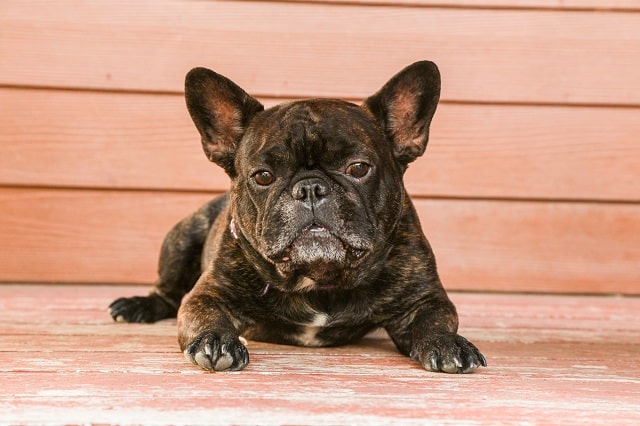
Brindle French Bulldog
A brindle coat is a pattern of alternating stripes or swirls of different colors on top of a base color. The stripes or swirls can be black, dark brown, or grey, and the base color can be any shade of fawn or cream.
The term “brindle” is believed to have originated from the Old Norse word “brandr,” which means “to burn,” referring to the fiery appearance of the coat pattern. The brindle pattern is a result of specific genetic variations that affect the distribution of pigment in the coat.
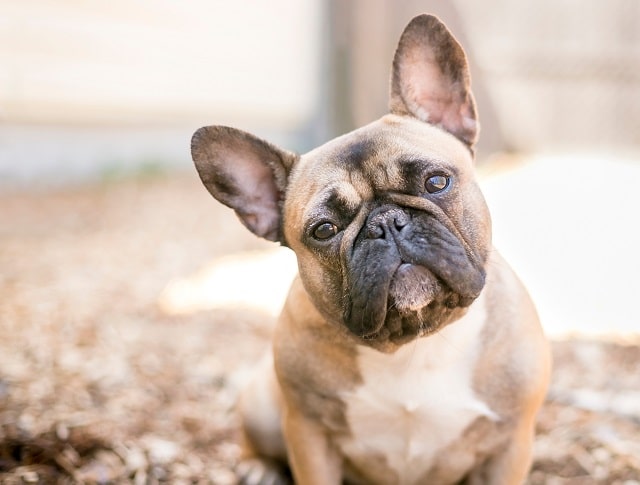
Fawn French Bulldog
The fawn coat color in French Bulldogs is a result of specific genetic variations that affect the production of melanin, the pigment responsible for skin and coat color. The fawn color ranges from light tan to dark reddish-brown and is the result of a recessive gene that affects the production of melanin in the coat. The fawn coat color is often described as solid with no distinct markings.
The name “fawn” refers to the color of young deer with a similar reddish-brown hue. Fawn French Bulldogs are highly sought after for their unique and elegant appearance. However, it is important to remember that coat color should not be the only consideration when choosing a French Bulldog. It is crucial to choose a reputable breeder who uses responsible breeding practices and prioritizes the health and well-being of their dogs, regardless of their coat color or pattern.

White French Bulldog
The French Bulldog coat color “white” is a result of a recessive gene that masks any other color. In other words, if both parents carry the recessive “white” gene, their puppies will be born with a white coat. Despite being relatively rare, white French Bulldogs are still highly sought after by some potential owners due to their striking appearance.
It is important to note that while the “white” coat color is recognized by some breed standards, including the FCI, the AKC only recognizes white as a permissible color for French Bulldogs, rather than a standard color. This means that while a white French Bulldog can compete in AKC shows, it may not be judged as favorably as dogs with recognized standard colors such as brindle or fawn.
Overall, the “white” coat color is a beautiful and unique variation of the French Bulldog breed. However, it is important to prioritize responsible breeding practices and the health and well-being of the dog above all else when selecting a white French Bulldog.
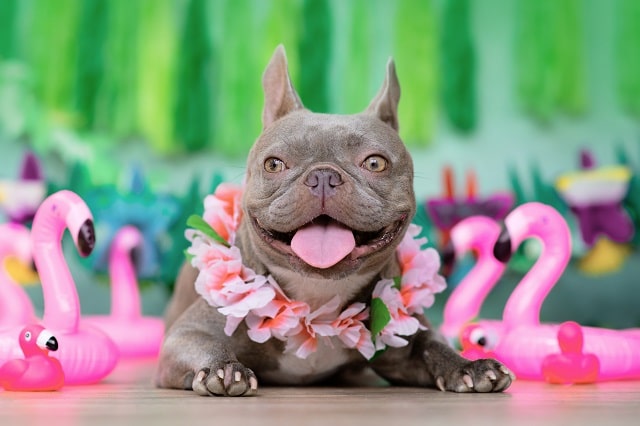
Lilac French Bulldog The Rarest Color
The French Bulldog’s coat color known as “lilac” is a diluted version of the “chocolate” color, which results in a lighter, pastel shade of brown. The color is achieved when a dog inherits two copies of the “d” allele, which is a dilution gene.
The term “lilac” is used to describe this color because it resembles the pale purple color of the lilac flower. The term is commonly used in the dog breeding community, but it is important to note that the American Kennel Club (AKC) does not officially recognize the lilac color in French Bulldogs as it falls outside the breed standard.
Official AKC Color for French Bulldogs
The American Kennel Club (AKC) is the most prominent registry for purebred dogs in the United States, and it sets the standards for each breed’s characteristics, including physical attributes, temperament, and coat color. For French Bulldogs, the AKC only recognizes certain colors as standard, which are considered the breed’s official colors.
According to the AKC breed standard, the standard colors for French Bulldogs are brindle, fawn, and white. These colors can be solid, piebald, or brindle with white markings. The AKC also recognizes variations of these colors, including cream, cream, and white, fawn and black, and fawn brindle.
It’s essential to note that although the AKC sets the standard for French Bulldog coat colors, the organization does not endorse or promote any specific coat color or pattern. Instead, the AKC emphasizes the importance of responsible breeding practices that prioritize the health and well-being of the dogs, regardless of their coat color or pattern.
It is also important to remember that coat color should not be the only consideration when choosing a French Bulldog. While certain colors may be more popular or highly sought after, it is crucial to choose a reputable breeder who uses responsible breeding practices and prioritizes the health and well-being of their dogs. By doing so, you can ensure that you are bringing home a healthy and happy French Bulldog, regardless of their coat color.
Conclusion
n conclusion, French Bulldogs are a popular and beloved breed that comes in a variety of coat colors and patterns, including brindle, fawn, white, blue, chocolate, merle, and pied. While some colors may be more sought after than others, it is crucial to prioritize responsible breeding practices and the health and well-being of the dogs above all else.
The AKC only recognizes certain colors as standard for French Bulldogs, including brindle, fawn, and white, and it is essential to choose a reputable breeder who uses responsible breeding practices when selecting a French Bulldog.
Understanding the different types of French Bulldogs and their unique coat colors and patterns is essential for any potential owner, as it can help them make an informed decision when selecting a puppy. Owners can enjoy a lifetime of love and companionship with their furry friend by prioritizing responsible breeding practices and choosing a healthy and happy French Bulldog.
Many additional resources are available for readers who want to learn more about French Bulldogs, including breed-specific organizations, online forums, and reputable breeder directories. These resources can provide valuable information on the breed’s history, temperament, and care requirements, as well as tips for selecting a reputable breeder and maintaining a healthy and happy French Bulldog.
